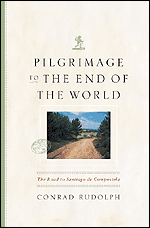"A delightful read and a work of real literary qualities. Light of touch, evocative and brimming with rich detail, it is at the same time a highly serious effort. In a book both personal and affecting, the author offers us something of a journal of his own internal spiritual development along the route to one of Europe's most important pilgrimage destinations. Filled with shrewd insights about the agonies and ecstasies that come from weeks upon weeks of physically grueling walking over the back roads of France and Spain, the book also serves as practical travel guide to those who would follow in Rudolph's footsteps."—Ivan Strenski
"If you plan to emulate his example, and require a preparation for that elusive inner expansion, then this modest and likeable book should be among your gear."—Salley Vickers, Times
![]()
Helpful websites:
The Routes of Santiago de Compostela in France (UNESCO)
Route of Santiago de Compostela in Spain (UNESCO)
El Camino de Santiago (UCLA/John Dagenais)
Pilgrimage to the
End of the World
The Road to Santiago de Compostela
Conrad Rudolph
Doing the Pilgrimage
The pilgrimage to Santiago is a journey like nothing else you've ever done. On this journey, every day has the potential of presenting something completely new. In order to be receptive to this experience, the attitude of the pilgrim has to be free, spontaneous, unstructured. The pilgrimage is not free of contradictions, however, and one of its many little ironies is that the first step toward this state entails a certain amount of very practical preparation ahead of time. It doesn't take much, but it must all be done.
The Route
The pilgrimage to Santiago can begin from anywhere. But on the basis of the twelfth-century Pilgrim's Guide, there are said to be four classic starting points.
While modern guide books exist for all four routes, by far the most beautiful is the one from Le Puy, in the heart of the Massif Central. It's also the route with the best-preserved pilgrimage churches from the Romanesque period and the one taken by the vast majority of pilgrims today. This is the route that I took and that I have in mind when I describe the pilgrimage.

Although a medieval pilgrim from north of the Pyrenees might follow any route he or she chose to Santiago, the twelfth-century Pilgrim's Guide tells us that pilgrims traditionally followed four main routes, all of which eventually joined in Spain at Puente-la-Reina. The exact roads were based on a combination of simple geographic logic and the strength of attraction of whatever holy places happened to be in their general vicinity. Sometimes they took advantage of the Roman and medieval road systems, and at other times they completely disregarded the practical in pursuit of the sacred. The Le Puy to Santiago route is indicated by a straight line, the other three traditional routes by dashed lines. (Map: Claire Clement)
The entire pilgrimage from Le Puy, in south-central France, to Santiago, in northwestern Spain, is around a thousand miles (sixteen hundred kilometers) and takes about two and a half months. This includes getting to Le Puy, the occasional rest day along the way (I had rest days at Conques, Moissac, Burgos, and León because of their interest), a three-day hike beyond Santiago to Finisterre, a day or two at the celebrations of the Feast of Saint James, and the return.
It's my personal belief that some of the sensations I describe elsewhere in my book, Pilgrimage to the End of the World, are experienced only with more than a month of walking (that is, more than just the Spanish route). Very few people, however, can manage such a long trip. Most people walk a small part of the way, usually on the Spanish route (typically finishing at Santiago), although other parts of pilgrimage route are done as short walks as well.
A popular yet more challenging alternative is to undertake all of the Spanish route—called the camino francés because so many French pilgrims took it in the Middle Ages—at one time, typically beginning at Saint-Jean-Pied-de-Port or Roncesvalles. If you choose to do this, I recommend beginning at Saint-Jean (on the French side of the border) rather than at Roncesvalles (on the Spanish side), so that you will have the experience of crossing the Pyrenees.
Still others do all of one of the "classic" pilgrimage itineraries—such as that of Le Puy to Santiago—but in shorter segments, breaking the entire trip down into however many parts they have the time and energy for. For example, some who do the Le Puy to Santiago route by these still demanding segments break it down into France and Spain, with the French leg being a little over four weeks and the Spanish a little over five.
Those who are really pressed for time—that is, almost everyone—but who nevertheless want to walk all of the "classic" Le Puy to Santiago route further break down each of the longer legs into two, for a total of four segments of roughly two and a half weeks each. For example, the first segment might be from Le Puy to Moissac (around halfway from Le Puy to the Pyrenees). The second segment might be from Moissac to Roncesvalles (the first Spanish town after crossing the Pyrenees, and about halfway from Le Puy to Santiago). The third might take the pilgrim from Roncesvalles to León, one of the great cities of Spain (around halfway across Spain from Roncesvalles). And the fourth might be from León to Santiago—and for the truly obsessed, beyond Santiago to Finisterre.
These four segments more or less correspond to the four main geographical regions of the Le Puy to Santiago pilgrimage route.

A satellite image of the pilgrimage routes provides a little reality check to the bland abstractions of a traditional map. But even this isn't enough to convey the toughness of the trail. The daunting mountain ranges of the Pyrenees and the Cantabrians speak clearly enough of the great challenges the pilgrim must overcome. But the lower elevations of Gascony, just north of the Pyrenees in southwestern France, appear fairly tame from five hundred miles up when, in fact, their broken ground can, at times, be as demanding as any of the more visibly imposing trials of the way. (Image: NASA/Claire Clement)
The Le Puy to Moissac segment leads through one of the most beautiful parts of Europe, the Auvergne and the Lozère, as stunning in their own ways as the most magnificent parts of Wyoming and Colorado. Except for the occasional village, you may travel for days through the high plateaus and herds of grazing sheep and cattle without seeing more than a handful of people. Along the way, you might stay at the twelfth-century Knights Templar grange of Le Sauvage; visit Conques, one of the most evocative Romanesque pilgrimage monasteries in France; see any number of enchanting villages you've never heard of before and never will again; and wind up at Moissac, a few days out of the Massif Central, where the greatest extant Romanesque sculpted cloister survives intact. Food is one of the great experiences of travel, and the food in this region is exceptional.
The Moissac to Roncesvalles stretch sticks out in my mind as the most challenging part of the whole pilgrimage. Running mostly through Gascony, I thought it had both the most difficult geography—a rough and sometimes wild region of low, rolling terrain—and people among the most receptive to pilgrims of the entire trip. Once in a while there may be problems finding a place to stay on this stretch. But this is all part of the fun—like stopping at Saint-Antoine, a little town with no hotel, no restaurant, no café, and no stores, only an unattended gîte, where a woman about thirty-five years of age cooked us dinner at her home and brought it to us for no apparent reason other than that someone had to do it; in clothes, manner, personal appearance (disarmingly beautiful), and mode of transportation (Volvo station wagon, of course), she would have fit right in in my hometown of Brentwood, California. Saint-Jean-Pied-de-Port—with its quaint old church and winding streets made festive with window boxes of bright, colorful flowers—is the last town on the route in France and an old pilgrimage and mountain-pass trading town very picturesquely situated at the mouth of the pass of Roncesvalles. It is from here that the pilgrim begins the ascent of the Pyrenees, an experience not to be forgotten. (Be sure to take the ancient upper road that goes over the mountains, not the easier one that runs through the bottom of the pass.) Shortly after the summit, the descent leads to Roncesvalles, one of the greatest of the old pilgrimage monasteries and the legendary place of the death of the epic hero Roland. Just over the Spanish border, in the very heart of the Pyrenees, lies Roncesvalles, shrouded in both fog and time.
In sharp contrast, the weary pilgrim is energized by the urban air of Pamplona, only a few days out of the mountains on the route from Roncesvalles to León. In this sophisticated regional capital, the whole city seems to come out at night to stroll the ancient but very fashionable and lively center of town. This is Basque country, and it is noticeably different from what you will encounter before and what you will encounter after it. The pilgrimage route in general is lined with the ruins of the past, but nowhere are they more plentiful and fascinating than on this stretch—something that in no way is made any less interesting by the fact that this part of the route runs through La Rioja, the most famous wine-producing region of Spain. It can be a bit hot in Spain in the summer, especially along the stretch of the route from Burgos to León. But the rich historical layering of this segment of the pilgrimage route more than makes up for it. This is the country of El Cid, and both Burgos and León are among the great cities of Spanish history and culture, with stunning cathedrals, great urban architecture, fine museums, and marvelous food. It is also the heartland of the pilgrimage, with long stretches of sun-beaten trail straggling across the Meseta, the famous tableland of Castile and León, and here the pilgrim finds out just what the pilgrimage is all about.
One thing that makes the pilgrimage different is the attitude toward it of the people who live along the way. Whether the eccentrics who live in the hills and who have devoted their lives to the pilgrimage, or simply the wonderful Spanish people, the last segment, León to Santiago, has them in droves. This largely mountainous segment, which begins toward the end of the Meseta, is one of the regions of western Europe least touched by modern times and among the most beautiful of the entire trip. Two of the great stops here are Rabanal del Camino and O Cebreiro, both situated on the ridges of mountain ranges that must be crossed. At Rabanal, the pilgrim is greeted by one of the most welcome refugios of the trip, a fifteenth-century house beautifully restored and run by the British Confraternity of Saint James. And it may have just been my frame of mind at the time, but O Cebreiro seemed to be a very special place, both for its general feeling of existing in another time and for the fact that I seemed to run into interesting people one after another.
The wise pilgrim plans the trip so that he or she will arrive in Santiago a few days before the feast day of Saint James, July 25. The city virtually explodes with activity for several days previous, culminating in a great spectacle in the plaza in front of the cathedral on the eve of the feast day. During all this time, the city is alive with fireworks, parades of gigantes and cabezudos (giant puppets), plays, people running around in costumes, and every kind of music imaginable, including Spanish Celtic folk music, in which the bagpipe is a central instrument and which is perhaps most easily described as the Galician counterpart to traditional Irish Celtic music. (This part of Spain, Galicia, is an old Celtic region.) One of the most popular events of the elaborate half-week of festivities is the swinging of the centuries-old, solid silver censer called the botafumeiro.
The trip is not really complete, in my opinion, without the final three-day journey on foot to Finisterre. This was where in ancient times the known world reached its westernmost extent, and the destination of a pagan pilgrimage from which the Christian pilgrimage to Santiago took its symbol, the scallop shell. It's also a place of astonishing beauty.
For those who do the long-term pilgrimage, and even for those who do the shorter segments, the length and difficulty combine with the special treatment given the pilgrim to create an experience unlike any other. Yes, it's difficult to find the time and money, and even more difficult to do. But for those who want something more, you'll find it on the long, hard trails of the pilgrimage to Santiago.
Copyright notice: Excerpt from pages 95-104 of Pilgrimage to the End of the World: The Road to Santiago de Compostela by Conrad Rudolph, published by the University of Chicago Press. ©2004 by the University of Chicago. All rights reserved. This text may be used and shared in accordance with the fair-use provisions of U.S. copyright law, and it may be archived and redistributed in electronic form, provided that this entire notice, including copyright information, is carried and provided that the University of Chicago Press is notified and no fee is charged for access. Archiving, redistribution, or republication of this text on other terms, in any medium, requires the consent of the University of Chicago Press.
Conrad Rudolph
Pilgrimage to the End of the World: The Road to Santiago de Compostela
©2004, 144 pages, 28 halftones, 5¼ × 8
Cloth $30.00 ISBN: 0-226-73125-1
Paper $13.00 ISBN: 0-226-73127-8For information on purchasing the book—from bookstores or here online—please go to the webpage for Pilgrimage to the End of the World.
See also:
- A catalog of medieval studies titles
- A catalog of art titles
- Other excerpts and online essays from University of Chicago Press titles
- Sign up for e-mail notification of new books in this and other subjects
